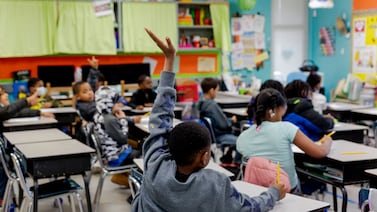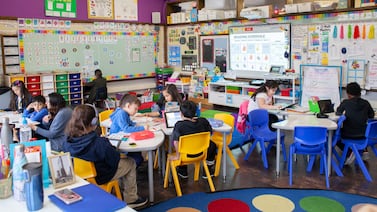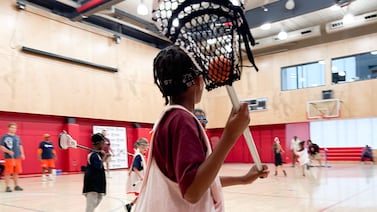A pandemic-era rise in youth joblessness and disconnection hit young Black women in Chicago especially hard, almost doubling their unemployment rate, according to a new report from the University of Illinois Chicago.
According to the study, about 45,800 16- to 24-year-olds were not in school, college, or the workforce in Chicago. Across the state, 177,000 were out of work and out of school in 2021.
Matthew Wilson, an associate director at the Great Cities Institute at the University of Illinois and one of the report’s authors, said the increase in the jobless rate for Black women aged 20 to 24 — from 32% in 2019 to almost 60% in 2021 — was the study’s most staggering finding.
“As conditions continued getting better for other people, they continued to get a lot worse for young Black women,” Wilson said.
Chicago and Illinois have also been much slower to recover from a spike in youth unemployment than the country as a whole, and they have seen racial disparities in jobless rates widen more, the report found. Even as employment rates for young whites and Latinos in Chicago and statewide have bounced back, they have worsened for Black youth.
The report was commissioned by the nonprofit Alternative Schools Network to help make the case for a bill to launch a $300 million statewide youth jobs program introduced in the Illinois Legislature this year. The bill, sponsored by state Rep. Kam Buckner and state Sen. Robert Peters, both Chicago Democrats, would enlist community-based organizations across the state to help coordinate jobs for as many as 80,000 teens and young adults.
The issue of youth who are not in school, college, or the workforce has long bedeviled Chicago and other cities, despite research tying the problem to persistent poverty and violence rates. City leaders have argued that finding solutions is key to combating a rise in gun violence, and Mayor-elect Brandon Johnson has set a goal of doubling the number of youth summer jobs.
Chicago likely fared worse than the country as a whole because it’s a segregated urban area with ingrained uneven access to job opportunities, said Wilson.
“Chicago is an extreme site of those types of inequities,” he said. “It has more areas of concentrated disadvantage than the nation as a whole.”
Chicago has a youth summer jobs program, One Summer Chicago, which lined up jobs for 20,300 youth in 2022, according to city data.
Organizers from the Alternative Schools Network are staging a Thursday press conference in downtown Chicago to share the report’s findings and push for the youth jobs bill. They planned to display a coffin to symbolize the gun deaths of youth on the city’s West Side and have a plane flying overhead with a banner reading “Jobs Stop Bullets.”
For young people, disconnection from school and work has been shown to adversely affect health, relationships, and odds of experiencing violence and incarceration.
Overall, joblessness among residents in that age group jumped higher for Black youth than for any other demographic group during the pandemic, to more than 57%. That rate remained elevated even as nationally, unemployment rates for teens and young adults have largely returned to those on the eve of the COVID outbreak.
Williams said the “stark” impact on young Black women stood out. Pre-pandemic, male Black teens and young adults were much more likely to be unemployed and disconnected from school. But during COVID, the employment rate for young Black women outpaced an already “astronomically high” rate for their male counterparts, Williams said.
The reasons for that trend need to be studied more closely, Williams said. One possible factor is that the responsibilities of overseeing remote learning and child care during COVID’s shutdowns fell disproportionately on Black women, who might be more likely than other racial groups to work jobs that could not be done remotely.
The report also notes that youth jobs programs have previously been shown to yield strong returns on investment, paying off in reductions in crime and other positive outcomes.
Kemon Johnson, who is graduating from Youth Connection Charter School’s West Town Academy campus this summer, said youth like him face a Catch-22: They are eager to get a foothold on the job market, but prospective employers don’t take them seriously without any job experience.
Johnson, who is slated to speak at Thursday’s press conference, said he learned helpful skills working at a small custom shirt and shoes business his mom runs and through the One Summer Chicago jobs program. At his alternative high school, he earned certifications in food handling, forklifting, and CPR. But he is still daunted by the goal of finding a full-time position this summer before heading off to community college.
One of Johnson’s classmates, Rianna Jones, who works at a local trampoline park, says having a job has helped her take care of family and basic needs. “It’s helped me see how the real world is,” she said.
Jack Wuest, the head of the Alternative Schools Network, said the group — a long-time advocate for youth employment — commissioned the study to look at where the numbers stood amid the pandemic recovery and to help advocate for a new statewide jobs program.
A pair of bills proposing that program haven’t had any movement in the legislature since March, but a week or so is still left in the spring session.
“The more young people work at that age, the more they will work later,” Wuest said. “It will not only help young people move forward but also help reduce crime and help a lot of businesses facing severe labor shortages.”
The Alternative School Network worked on the legislation that would launch a $300 million statewide program and is part of a coalition of community-based organizations and others pushing for its passage. These organizations would contract with the state to administer the program. They could hire some young people and help others secure jobs with private employers, stepping in to prepare youth and troubleshoot when issues arise in the workplace.
That kind of support can make or break a youth employment program, said Wilson, the report’s author. Job placement programs that simply send off young people without work experience to jobs for which they are not prepared haven’t shown great results, he said. Wilson said youth need not just specialized job training, but also help learning the soft skills needed to keep a job.
“The idea that tomorrow you just offer a job to a young person and they are going to be successful is unrealistic,” he said.
Mila Koumpilova is Chalkbeat Chicago’s senior reporter covering Chicago Public Schools. Contact Mila at mkoumpilova@chalkbeat.org.






